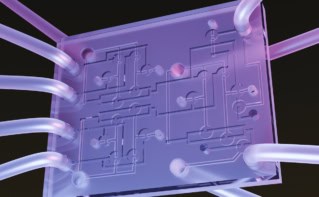
A simple twist has achieved a record-high anisotropy in thermal conductivity, reports an international group of researchers at the University of Chicago, University of Illinois at Urbana-Champaign, Cornell University and the Chalmers University of Technology. Their versatile approach could be used to cool nanoelectronic devices internally.
As described by Moore’s law, the number of transistors in integrated circuits is doubling every two years. But as computers become faster, the heat they produce also increases. To tackle this problem, one needs materials with high thermal conductivity, and even better materials with thermal properties that are anisotropic. Anisotropic materials have high thermal conductivity in some directions and low thermal conductivity in other directions. This means that they can simultaneously dissipate heat from a hotspot (local overheating) in directions with high thermal conductivity, while providing thermal insulation in other directions.
Layered materials
In this latest research, van der Waals crystals were used as starting materials. These are materials such as graphite and molybdenum disulphide, which comprise atomically thin layers that are stacked together. They combine strong in-plane bonding with the weak cross-plane bonding, which allows for the easy separation of the layers.
The team, lead by Jiwoong Park, David G Cahill and Paul Erhart, showed that by utilizing the anisotropy of van der Waals crystals and interlayer rotation, the thermal conductivity in the stacking direction can be suppressed to that of twice the thermal conductivity of air.
“Our nanomaterial film behaves as if it were 2D,” says Shi En Kim, who is a graduate student in molecular engineering at the University of Chicago. “Heat flows through the sheets as sluggishly as if through the air. That’s quite surprising, considering what we have here is a fully dense solid.”
High and ultralow thermal conductivity
Van der Waals materials combine strong in-plane bonding with weak bonding between planes. However, it is hard to change the conductivity of only one axis. It is known that twisting the two layers of graphene by a certain angle produces novel electronic properties. In the same line, researchers have incorporated twists in the single-layered molybdenum disulfide nanosheets by stacking monolayers of molybdenum disulfide randomly, leading to symmetry breaking in the cross-plane direction but preserving the perfect crystalline order in the in-plane direction.

Electrons in twisted graphene ‘freeze’ when heated
They were thus able to preserve the high in-plane conductivity of a pristine bulk crystal, but the crystalline mismatch of the layers leads to increased phonon scattering, and ultra-low thermal conductivity, in the cross-plane direction. Currently, the ratio between the in-plane and cross-plane thermal conductivity of the material is a record high, reaching 900. This beats the previous record of 340 set by pyrolytic graphene.
The material was tested in a real-life application by being used as a heat-spreader for gold electrodes, which are a proxy for the nanowires that run through modern-day portable electronics. One gold electrode was covered with the molybdenum disulfide layers, while the other was not. When an electrical current was passed through the electrodes they warmed up due to Joule heating. The team found that the pristine electrode deteriorated quickly from overheating. The electrodes covered with molybdenum disulfide, however, were still functioning due to the cooling effect coming from the effective heat dissipation in the in-plane direction
The authors insist that this approach is not limited to molybdenum disulfide but could use many different 2D materials. Due to the infinite variability of possible combinations of 2D materials, this breakthrough opens a huge area of future research where the thermal conductivity of materials can be finely tuned.
The research is described in Nature.



